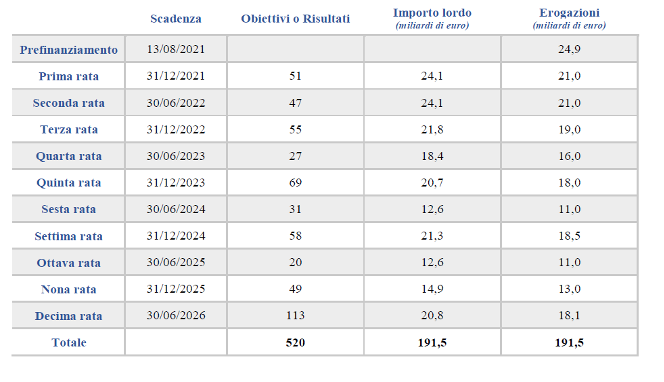Pnrr, here are ends and unknowns

Speech by Alessandra Servidori, professor of labor policies, member of the Steering Council for programmatic activity in the field of economic policy coordination at the presidency of the Council
As of today, 29 January 2022 it seems useful – while the merry-go-round for the election of the President of the Republic continues to whirl – to dwell on the implementation of the Recovery Plan and I find it correct to begin with the statement by President Draghi who continues to recommend to us: "Italy must combining imagination, planning skills and concreteness, to hand over a more modern country to the next generations, within a stronger and more supportive Europe ". Remembering the roadmap that Goretti, coordinator of the control room of the PdC published is still and always valid.

In December at the Rome Investment Forum, Minister Franco declared that the Italian government had completed 35 of the 51 milestones agreed with Europe by 2021. There were still 16 objectives to be achieved by the end of the year in order to receive the second tranche of 20 funds. billions. And to speed up the implementation of the program, ministries have given "weekly rather than monthly goals" to the ministries. And to this end, measures have been approved that make it possible to achieve eight objectives, including the green light for the revolving fund to support businesses for energy redevelopment, environmental sustainability and digital innovation and the framework law on disability .
However, many goals are still in trouble. And not just for political reasons. But also because the regulatory measures necessary to set them in motion are many: 549 have been launched, most of which however require further rules and regulations for implementation. Among the 16 missing targets, there remain the decrees for the reform of civil justice, the implementation of the "Customs Single Desk", the completion of the hub for digital tourism, the implementation of interventions for disability, but above all the recruitment of 1,000 public administration technicians for the implementation of the NRP who are slow.
For the recruitment of professionals (to be divided among the Regions) who must "provide technical assistance and strengthen the creation of capacity for the implementation of the NRP", the procedures have not yet been concluded. The reform of the civil process is well underway, and the implementing decrees are expected to come into force. Same thing for the reform on insolvency and for that on public procurement and concessions. On the labor front, after the approval of the decree on GOL, Guarantee of Employability of Workers, the implementation of local plans by the Regions is now awaited and with the approval of Anpal, the first funding that will arrive starting from January 2022.
On the environmental issue, the green-inspired objectives led to the extension of the Superbonus and the Minister of Ecological and Environmental Transition accelerated it and published the decrees with the selection criteria for separate waste collection projects and plants on the website. for recycling, for which a loan of 1.5 billion euros is foreseen, and for the “flagship” initiatives of the circular economy (the cost of which is around 600 million). To these is also added the decree approving the operational plan for the advanced and integrated system for monitoring and forecasting hydrogeological risks (the financing of which is instead around 500 million and mainly concerns the South). There is a need to accelerate the chapter of reforms, in particular in the field of “green” gases, water and atmospheric pollution, which are crucial to pave the way for investments. To achieve the digital and ecological transition, in addition to the investments and reforms envisaged in the Government's agenda, the right human capital is needed. And, above all, it is necessary to create new skills and new digital and green professional profiles, which are in short supply in Italy today.
With the PNRR it will be possible to presumably create 380 thousand new jobs among women and 81 thousand among young people. But as long as the right skills and adequate active policies are created to respond to the demand for new jobs that comes from the Plan. Of the six missions of the plan, the common denominator is precisely work. For each mission of the NRP, we must build the concrete content through the human resources that will apply it.
The public administration is at the forefront with the Department of the Civil Service which has created an ad hoc platform, inPa, which is also used for the selection and recruitment of technicians and experts – divided between the different Regions – who serve the administrations to put into practice the investments of the NRP. But from the municipalities comes the alarm about the lack of professionalism capable of managing and "grounding" the resources.
The government has decided to devote the first stages of the plan to approving general reforms and to reserve public investment and private investment incentives for the next few years. This choice allows the government to respect the first commitments requested by the European Commission without affecting the disbursement of funds due to the difficulties of local authorities. But the concerns remain because the implementation of the plan to be implemented in a short time requires to reflect from the beginning on what tools are necessary to overcome any, possible and probable implementation criticalities.
We recall that there are 298, almost 300, the lines of intervention that will have to be reported by 2026, as we all know. There are differences between reforms and investments, interconnected to arrive at 2026 with territorial lines and above all assistance, because territorial assistance is fundamental, what is important is the final data of what is posed with this set of results. When we talk about a plan of results we must have in mind, for each line of intervention, what is the final profound meaning of the actions that the administrations must implement to obtain that result.
We remind you that the control room examines the specific criticality profiles, the monitoring of compliance with the deadlines and the state of progress. So we again find times and results as the common denominator of the whole picture. An already set up and effective monitoring system is emerging and among the possible tools there are also those concerning the activation of the replacement powers.
The technical secretariat has the function of reporting cases for the purpose of exercising substitute powers, after the investigation, or it also sets up procedures for decisions aimed at overcoming dissent. It is important to remember that they are not only substitute powers, in case of inertia, but also the tools for overcoming dissent. The substitute powers also belong to the ministries, as direct owners of the individual lines of intervention, therefore in theory the control room, through the technical secretariat, intervenes as if it were in the second instance, if there has not already been an activation of a substitute power of the titular administration.
There is already a part of the legislation that has taken this into account, as criticalities have already been identified that would certainly have led to slowdowns on the basis of historical experience. Therefore, according to rules, administrative simplification tools in the field of tenders, the procedures for issuing, the centralization of authorization structures, both on cultural heritage and on the authorizations of via the control room recalls a power of the Presidency of the Council, which is present in the Constitution , and which is the exercise of the powers of direction, impulse, general coordination on the implementation of the interventions of the NRP. As with these powers of direction, impulse and general coordination, it can intervene to block or reduce critical issues when, for the implementation of the interventions, one returns to the main meaning: that is, that the interventions are public policies and one must first of all start from the final objective and the plan allows to start with the final objectives. It must define a time schedule, i.e. the various administrative phases to achieve that result, assign times to each phase, compatible with the deadlines of the measure, and identify strategic and operational criticalities.
Therefore, the thorny issues remain on the activation of supports and support, but also the problem of opposing interests such as that of installing clean energy and the need and will to protect a territory. This is why the logic of the policy, that is the logic of a comparison of values on what is the country's desire for the future and then, where this point of equilibrium of a value element between the two interests is found, identify a predictability of the criteria that in the within an administrative discretion, they guide authorizations and any compensation to the neighboring areas, even if replacement powers are triggered, we do not solve what is the main challenge of the NRP. That is to leave an audience that is able to design their policies in a more targeted and direct way to a result.
This is a machine translation from Italian language of a post published on Start Magazine at the URL https://www.startmag.it/economia/pnrr-ecco-fini-e-incognite/ on Sat, 29 Jan 2022 06:25:08 +0000.
